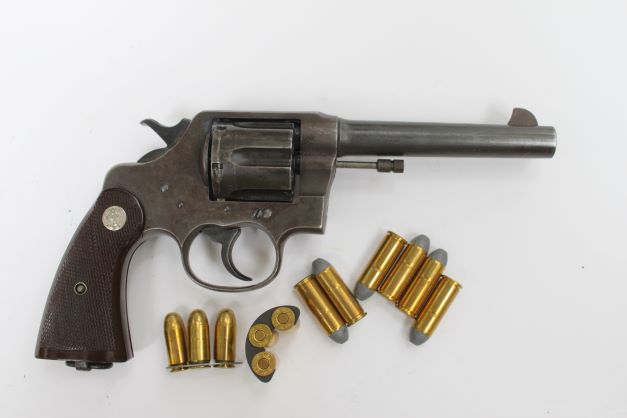
By Jim Dickson | Contributing writer
Colt had made a name for itself with the .45 Colt cartridge in the Model 1873 Colt Single Action Army revolver and the Model 1878 Colt double action revolver, both with side loading gates.
Both had immense stopping power but both were slow to unload and reload. Clearly a faster loading system was desperately needed.
The new swing-out cylinder double action revolver designs offered an answer. Colt’s Model 1892 Army revolver in .38 caliber led the way but while the Army bought it, savvy pistol men knew it fired a pipsqueak round. Needless to say they found no popularity as bear protection pistols and were considered only adequate for hunting small game with a pistol. Their abysmal failures to stop attacking Philippine Moros will never be forgotten and resulted in both 1873 and 1878 Colt revolvers being quickly re-issued. A group of 1878 double actions made with extra-large triggers and trigger guards for use in Alaska with mittens were quickly diverted to the Philippines. Even .44 caliber cap and ball revolvers left over from the Civil War were hurriedly pulled from storage were shipped off to the troops facing the Moros.
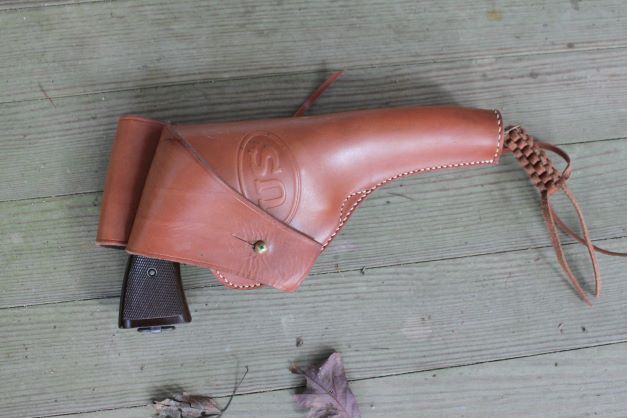
Fortunately for the Army Colt had scaled up and improved their Model 1892 to chamber the .45 which they called the New Service back in 1898. They were not about to turn over the lucrative large bore double action pistol market to their rival Smith and Wesson.
The Army had a problem with the .45 Colt round in a revolver with a star ejector though. The original rounds lacked sufficient rim size for reliable ejection as the rim was only .500” wide. This is why Winchester never had chambered their 1873 and 1892 lever actions for this round despite customer demand for it. At this rim size the cartridge would only reliably eject from a push rod system.
The Army needed a fast reloading .45 right now though so they increased the rim size to the maximum that would fit in a Colt New Service revolver’s cylinder which brought the rim size up to a whopping
.540”. The only problem was that with this rim size you could only load these rounds in every other chamber of the Colt Single Actions still in service. Still, this was fielded in the New Service revolver as the Model 1909 revolver which proved a great success in the Philippines against attacking Moros. Subsequently the ammunition companies increased the rim size of all .45 Colt ammunition to the maximum size that would fit in the smaller Colt Single Action’s cylinder resulting in the .512” rim size of today. End of problem.
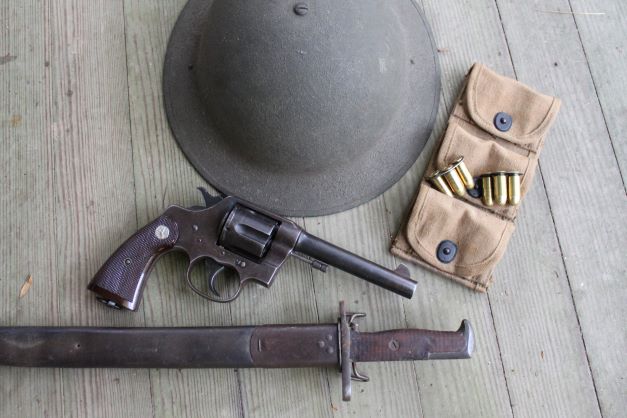
With the rim problem solved the sales of the .45 Colt New Service revolver took off. A lot of customers preferred the Colt to its S&W rival for the same reasons the army preferred it in the 1907 test trials. The Colt had a larger and more comfortable grip and trigger, simpler, stouter moving parts, and was easier and quicker to disassemble. The latter of interest primarily to Army Ordnance as taking apart a double action revolver is no job for amateurs.
Designed to stop a cavalry horse, the .45 Colt cartridge had proved equally adept at taking down bison, elk, moose, and bears of all kinds. In the big New Service revolver, this matchup of cartridge and gun was a huge success.
Colt chambered it for other popular big bore cartridges such as the 38-40 (a cartridge that should have been called the .40-40 as it is actually .40 caliber), .44-40, .44 Russian, .44 Special, and .455 Webley. In the latter caliber both the Canadian Mounties and the British army bought quantities. It was also made in small bores like .38 Special and .357 Magnum.
You could get about anything you wanted in barrel length. Standard lengths were 4, 4 ½, 5, 5 ½, 6 and 7 ½ inches. If you wanted a custom length Colt would happily make a custom order. Finish was either blue or nickel. I always think of my old friend Schley Howard when I think of Colt’s blue in that era for he always said “There is nothing prettier than Colonel Colt’s bright blue!”
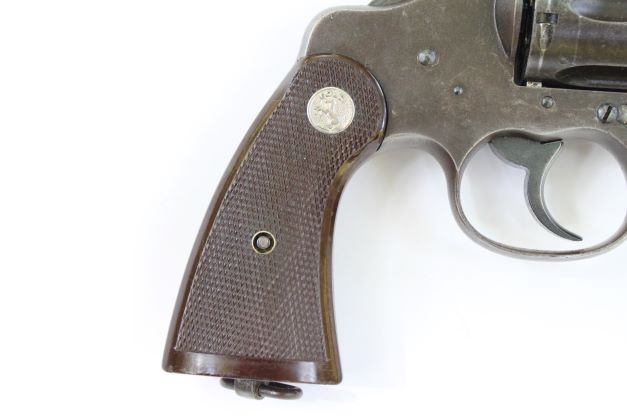
Grips were either walnut or Gutta-percha.
One thing about the grips that is most important. The inside curve of the grips has the forward angle of the Colt SAA and this makes them point much better than grips that angle backwards. To this day it makes the New Service the fastest large caliber double action revolver on target. As any of the old gunfighters still alive in that era would testify, that can be a lifesaving advantage. About that time the British Best Quality gunmaker Rigby was putting that grip angle on their double rifles and it worked out splendidly there. I have always shot better with this grip angle.
The New Service grips and trigger guard are also user friendly for a gloved hand, unlike the SAA with its small trigger guard. As someone who was once a licensed Alaskan trapper that means a lot to me. I have always felt that the New Service had the best ergonomics and handling of any double action revolver.
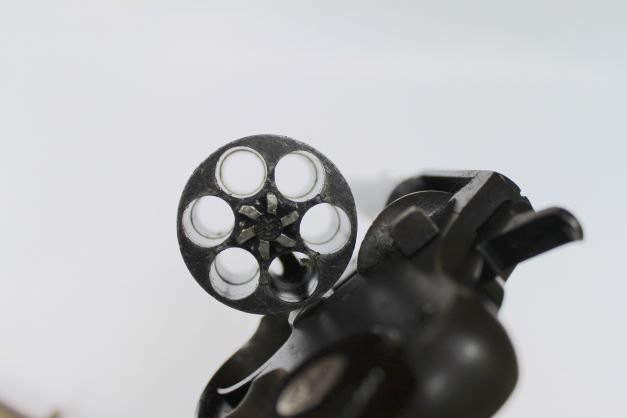
The target version of the New Service was called the Shooting Master and it was one of the most accurate revolvers out there then and now. It featured a flat top with adjustable sights. Later fixed sight New Service revolvers also had a flat top.
When Colt wanted to they could put one of the finest trigger pulls ever made on the New Service. These were equal or superior to any trigger pull on any other pistol. Alas, it was not a standard feature because it sure made double action shooting much easier. With one of these trigger pulls it didn’t take long to be shooting as accurately double action as single action.
When World War I rolled around the sidearm proved to be a decisive weapon in the close confines of trench warfare. America had plenty of men skilled in the use of handguns and equipping them with suitable sidearms became a top priority. There were not enough Model 1911’s to go around and they couldn’t make them fast enough to meet the demand so the Army turned to the revolvers that were already in production. As the .45 ACP was now the standard cartridge, the New Service was adapted to the rimless rounds by clamping them into two 3-shot half-moon clips. These also greatly cut reloading time. For practice though it is a lot less trouble to simply punch out the empties with a pencil rather than fool with those clips. Still, they can’t be beat for combat where they give the revolver almost the speed of an automatic for reloading.
About this time, Army Ordnance showed its dark side. Pistols were in short supply and there were plenty of .45 Colt SAA revolvers and 1909 New Service revolvers in inventory. Ordnance didn’t want to be bothered with handling two different pistol cartridges so they withheld these from the troops putting Ordnance convenience before the soldier’s lives in the best Army Ordnance tradition. It should be noted that in WWII and thereafter, Ordnance supplied both .45 ACP and .38 Special ammunition so they definitely could have handled two types in WWI if they had wanted to.
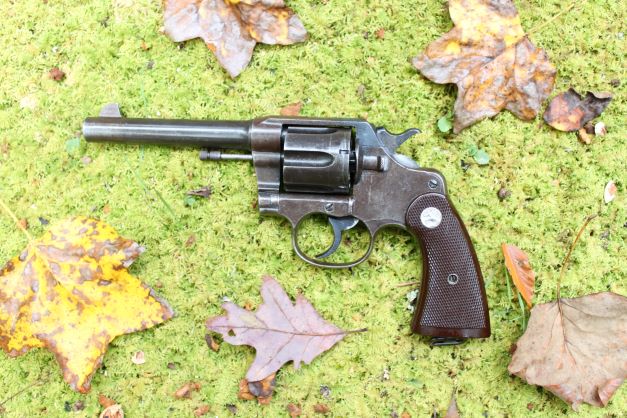
One place the Army preferred the New Service over the Model 1911 was for MP’s. When they had to pull a gun on a soldier they were arresting there was a lifesaving difference between the long double action trigger of the revolver and the short light trigger on the 1911 when a nervous MP had one covering a soldier that the Army had invested a lot of time and money in training.
While the Army was still issuing the Colt M1917 as late as the Viet Nam War, production was stopped at the beginning of WWII to make room for the wartime contracts. In a move the stockholders should have rebelled against, the tooling for the New Service revolvers was left outside where it rusted away during the war. Despite it being one of the greatest revolvers ever made Colt did not resume production after the war.
Colt no longer services this revolver but owners can get the same quality of work done at the old Colt Custom Gun Shop at:
O.F.M. Corp.
5151 Mitchelldale St.
Suite B14
Houston, Texas 77092
713-476-0888
They can keep this and any other old Colt going. The Colt New Service remains one of the finest and best pointing double action revolvers ever made. It is a crime that it is no longer made.



